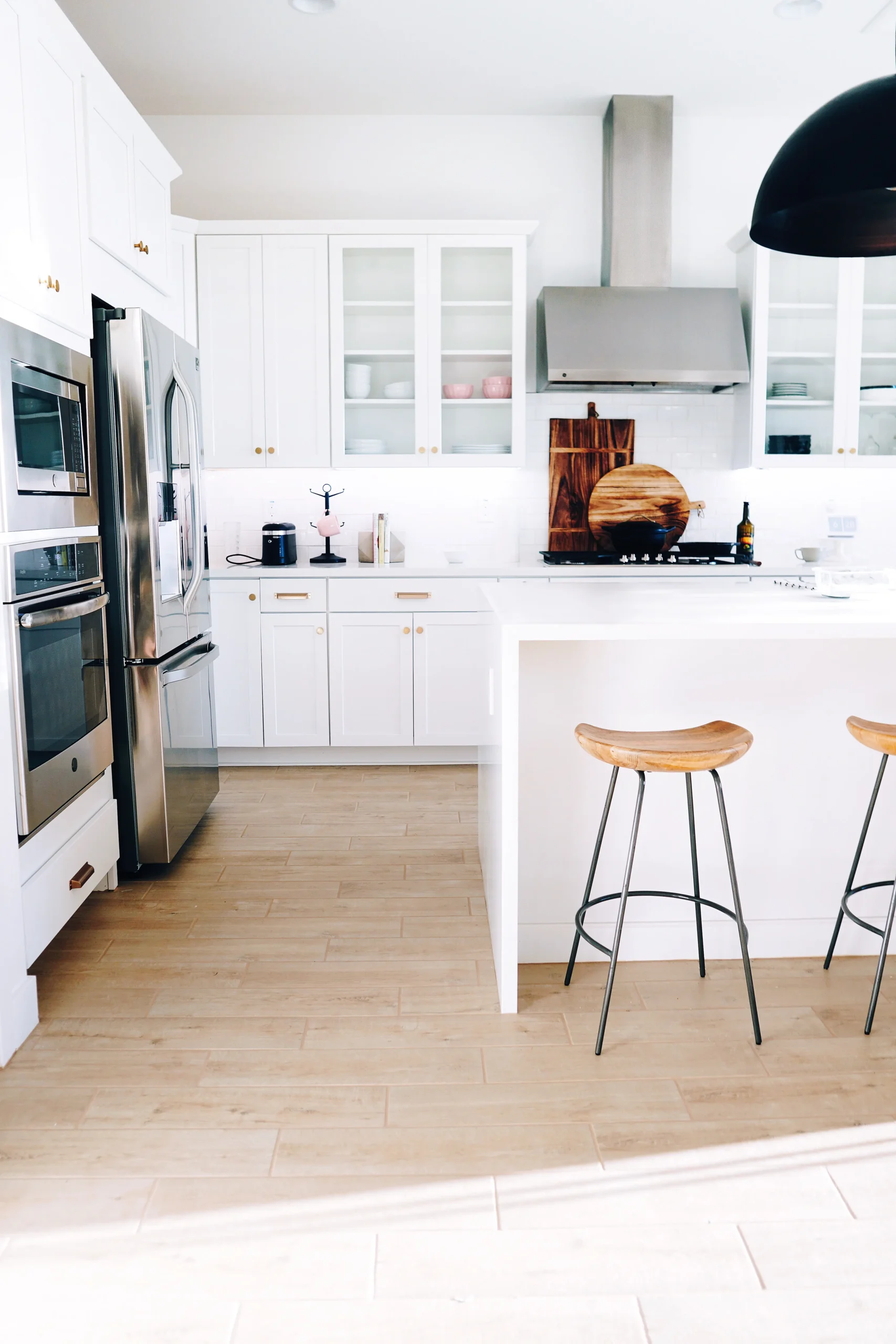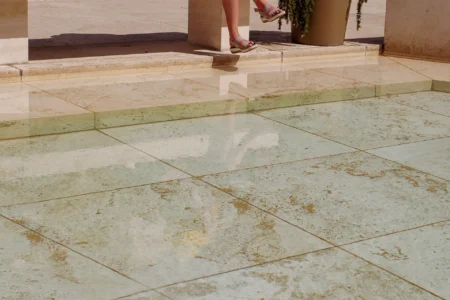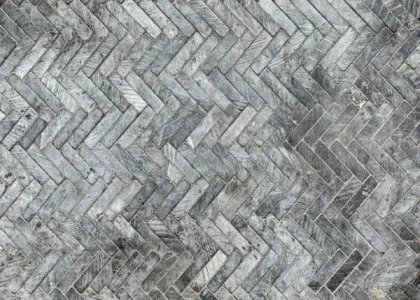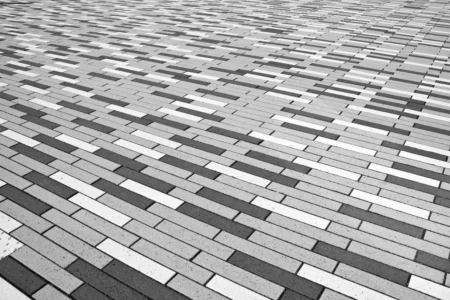Have you ever found yourself gazing at your tiled floors, wishing for a simpler, cost-effective cleaning solution that doesn’t involve harsh chemicals or expensive cleaning products? We’ve all been there. Today, I’m thrilled to share a surprisingly effective cleaning secret that’s been hiding in your pantry all this time – vinegar. Yes, you read that right!
In this post, we’ll explore how to transform this humble kitchen staple into a natural and potent solution that removes dirt, grime, and odors from your tiles, leaving them sparkling clean. Stick with me, and by the end of this journey, you’ll be armed with knowledge on creating your own vinegar-based tile cleaner, applying it to various tile types, and tips to keep your tiles looking fresh and shiny for longer.
Why Vinegar is Good for Cleaning Tiles
Vinegar, with its acidic nature and antibacterial properties, has long been underrated in its cleaning abilities. It’s a powerhouse that can dissolve stubborn dirt, cut through grease, tackle soap scum, and combat hard water deposits that accumulate on your tiles over time. Furthermore, its deodorizing properties can eliminate those unpleasant odors, breathing fresh life into your tiles.
Here are some reasons why cleaning tiles with vinegar can be a game-changer:
- Affordability and Accessibility: Vinegar is a staple in most kitchens and can be purchased from any grocery store without breaking the bank.
- Safety and Environmental Friendliness: Vinegar, being a natural product, poses no harm to your health or the environment.
- Versatility: From ceramic to porcelain to marble, vinegar can be used to clean a wide variety of tile types.
How to Make Your Own Vinegar-Based Tile Cleaner
Creating your own vinegar-based tile cleaner at home is a breeze, requiring just two ingredients: vinegar and water. Here’s how you can whip up this potent cleaner:
- Choose Your Vinegar: White distilled vinegar is a popular choice due to its availability and affordability. However, if the smell of vinegar isn’t to your liking, apple cider vinegar, with its milder aroma and added nutrients, can be an excellent alternative.
- Mix Your Solution: Combine equal parts of vinegar and water in a spray bottle or bucket. Adjust the ratio to suit your needs; if your tiles are heavily soiled, a higher concentration of vinegar might be necessary.
- Add Essential Oils (Optional): A few drops of your favorite essential oil can introduce a pleasant fragrance to your cleaner, transforming your cleaning experience. Lemon oil lends a fresh, citrusy scent; lavender oil provides a calming aroma, and tea tree oil adds an extra layer of antibacterial power.
How to Apply Vinegar-Based Tile Cleaner to Different Types of Tiles
Applying your homemade vinegar-based tile cleaner is a straightforward process, but a few tips can ensure you get the most out of your cleaning session.
- Preparation: Always start by sweeping or vacuuming your floor. This preliminary step removes any loose dirt or dust that might hinder the cleaning process.
- Application: Spray or pour your vinegar solution onto the tiles and let it sit for a few minutes. This dwell time allows the vinegar to loosen up any tough stains or dirt.
- Scrubbing: Use a soft-bristled brush or microfiber cloth to scrub your tiles. This step lifts any remaining dirt or stains, leaving your tiles spotless.
- Rinsing: After scrubbing, rinse your tiles with clean water to remove any vinegar residue. Be sure to wipe them dry with a clean cloth or towel. This prevents streaks or residue from forming on your tiles.
A few specific tips for different tile types:
- Ceramic or Porcelain Tiles: Be careful not to use too much vinegar or leave it on for too long, as this can damage the tile’s glaze or grout.
- Marble or Granite Tiles: Use a very diluted vinegar solution or consider avoiding vinegar altogether, as it can etch or dull the surface of these types of tiles.
- Textured or Patterned Tiles: A soft-bristled brush or toothbrush can help you reach into crevices and corners, ensuring a thorough clean.
How to Rinse and Dry Your Tiles After Cleaning
Rinsing and drying your tiles after cleaning might seem like an obvious step, but doing it right can significantly enhance the appearance and longevity of your tiles.
- Rinse Thoroughly: Rinse your tiles with clean water, ensuring you remove any vinegar residue. Neglecting this step might leave marks or odors on your tiles.
- Dry Immediately: Wipe your tiles dry with a clean cloth or towel immediately after rinsing. This simple action can prevent unsightly water spots or streaks from forming on your tiles.
- Buff Your Tiles: For that extra shine, consider buffing your tiles with a dry cloth or towel. It gives your tiles a polished, glossy finish, making them look as good as new.
Conclusion
Cleaning floor tiles with vinegar is a potent, natural solution that leaves your tiles gleaming. Vinegar’s ability to dissolve dirt, kill germs, and eliminate odors makes it an excellent choice for tile cleaning. By creating your own vinegar-based cleaner, you can easily and affordably maintain your tiles. Remember to tailor the vinegar solution to your specific tile type, and never underestimate the power of a thorough rinse and dry!
Embrace this eco-friendly, effective method and watch your tiles transform before your eyes. If you’re ready to dive deeper into the world of vinegar cleaning or need professional assistance for your tile cleaning needs, don’t hesitate to reach out. After all, who doesn’t love a sparkling clean, fresh-smelling tiled floor?
FAQs
Q: Is vinegar safe for tile floors? A: Vinegar is generally safe for most types of tile floors, as it is a natural and mild acidic solution that can dissolve dirt and grime without damaging the surface. However, vinegar may not be suitable for some delicate or porous tiles, such as marble or granite, as it can etch or dull the finish. It is advisable to test a small inconspicuous area of your tile floor before using vinegar on the whole floor.
Q: How often should I clean tile floors with vinegar? A: The frequency of cleaning tile floors with vinegar depends on how dirty your tiles are and how much traffic they receive. Generally, you should clean tile floors with vinegar once a week or once every two weeks to keep them fresh and shiny. However, you may need to clean them more often if they are exposed to spills, stains, or odors.
Q: What are the benefits of adding essential oils to vinegar-based tile cleaner? A: Adding essential oils to vinegar-based tile cleaner can enhance the cleaning and deodorizing properties of vinegar, as well as add some fragrance and extra benefits to your cleaner. For example, lemon oil can add a fresh and citrusy scent and boost the acidity of the vinegar, lavender oil can add a relaxing and soothing effect and reduce bacteria growth, and tea tree oil can add an antibacterial and antifungal boost and eliminate mold and mildew.
Q: How do I remove tough stains from tile floors with vinegar? A: To remove tough stains from tile floors with vinegar, you can use a mixture of baking soda and vinegar to create a paste that can lift and loosen stubborn dirt and stains. Apply the paste to the stained area with a scrub brush or a sponge and let it sit for a few minutes. Then wipe it off with a wet paper towel or cloth and rinse the area with clean water.
Q: How do I prevent streaks or residue from forming on tile floors after cleaning with vinegar? A: To prevent streaks or residue from forming on tile floors after cleaning with vinegar, you should rinse your tiles thoroughly with clean water and wipe them dry with a clean cloth or towel. This will remove any vinegar traces or dirt that can leave marks or odors on your tiles. You can also buff your tiles with a dry cloth or towel to give them a nice shine and polish.










